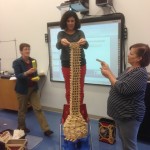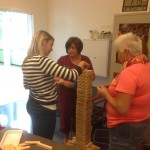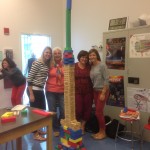On Monday, Mrs. Granahan, Mrs. Fleming, Mrs. Smith-Horn, and I spent the day at the Connecticut Science Center. As part of our work to bring cutting edge, research-based inquiry science instruction to students, we are involved in a program called Cultivating Young Scientists. This program presents teachers with graduate level work on different science themes that all focus on the use of inquiry. There are three themes for the program: water, nature, and structures. Ms. Catizone, Mrs. Lynch, and Ms. Szymaszk are starting their work in water next week. This week we were able to start our work with structures. When I tell you that this was the most fun I’ve had in a class, I am not kidding. We split our time between discussions on theory and practice, tasks involving structures, and reflection on our experiences. When the day was done, all four of us felt invigorated and energized, wanting to get right back to the classroom and implement some of our new learning.
Before we get to that fun though, I want to take a moment to talk about why building structures is important and what students are learning when they engage in the building of structures. First, let’s get right to it, as most people know it, building with structures is often called “playing with blocks.” It’s an activity about as old as children have inhabited the planet. Yet often, we set our children forth to play with blocks and think nothing more of it. “Let’s build a tower!” we say. “Can you build a wall?” we ask. This is about as deep as most folks get but there is so much more to think about both as teachers and parents. This was the real learning for us. When you think about structures, we have to think about all the forces that are at play when trying to accomplish a building task. You have to account for gravity. You have to think about balance and center of gravity. When building, your structure will undergo compression and tension. All of these are important factors in creating a viable structure that will be able to stand. When you think about it in the scientific light of forces, then the materials you choose become important. What size block should you use to start? What type of material will best support this structure? How can we create a strong foundation with blocks that might not fit together? All of these questions require that students account for the forces that are at play when building. Even more, students are engaging in the scientific process constantly when building. They are creating a hypothesis, testing that hypothesis, and they are making observations about the success, sway, and stability of their structure. This process then informs the next build that a student begins. One tip that our instructor gave us was to use blocks that did not interlock or use magnets. At first I was disappointed. This meant that I was not going to build with Legos and I love Legos. But then when you think about it, the interlocking nature of Lego bricks cause them to act in ways that defy those forces discussed earlier. Students are no longer being exposed to the same nature of gravity, friction, tension, and compression. So for the purposes of science exploration and understanding at this level blocks that don’t interlock are an exceptional teaching tool.
So the next time you say to your child, “Let’s play with blocks!” you can change your language and say, “Let’s build a structure that has a strong base, a low center of gravity and resists the compression brought on by such a large mass.” Or you could just keep that to yourself and know that you’re building a budding scientist who is becoming more and more engaged with the forces at play in the world.
Questions you might ask your engineer include but are not limited to:
What properties of this block will help it build a structure?
What type of structure would be best built by this type of block?
Which type of block would be best to build the foundation of your structure?
Why do you think your structure became wobbly?
What did you notice happen when you added that block?
Why do you think that happened?
What made your structure do that?
Why do you think your structure was/wasn’t successful?
What improvements can you make to your structure when you try it again?
What did you learn from building this structure?
Remember that the “Why?” and “How?” questions are the ones that will get you the best thinking. “Can you build this taller?” “Yes!” “How will you do that?” “I’m going to use some of the smaller foam blocks because they are not as heavy as the wooden blocks and the wooden ones will make it fall like last time, so I’m going to make it taller by adding blocks that aren’t as heavy.” The right question can really garner a great response.
Below you will find some pictures of our structures. We were charged with a task to build the tallest structure we could while using three different types of blocks. They had to be free-standing. Ms. Fleming’s group was the winner of our little contest, building a massive structure that stood nearly 8 feet tall without any outside support.
-Mr. Reed-Swale
- Mrs. Smith-Horn is hard at work.
- Mr. Reed-Swale’s group structure
- Instructor used for reference.
- The leaning tower of “Lisa”
- Ms. Granahan deep in thought.
- Careful placement of blocks.
- The winning tower and group!








Thanks for a great summation of our engineering experience! And, especially for preserving our creations with the photos!
WOW! That looks like an awesome program! I hope to use some of these ideas in my classroom. My students love to build and create using blocks. In fact, for our dance party (that they earned) they made a limbo bar out of math cubes! It was so creative and actually worked. Best of all, it was their idea. I hope to have enrichment groups with these kinds of activities that challenge the students to be creative and inventive.
Excellent work Discovery Team!
Lauren,
I’m not sure if you know, but we have all kinds of different Lego sets that cover everything from simple machines, to computer programmed motors. I can’t wait to get this amazing unit and program planned out for the second grade team. Feel free to stop over to the STEM room to check out some of the kits and the documents that came with them.
Tom